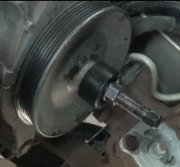What I'd look at first is how hard it is to turn the steering wheel when the car is not moving. If that has the normal resistance, and the steering effort only gets real easy at highway speeds, the next thing is to check the alignment. In particular, see if "caster" can be increased. Up through the mid '60s cars and light trucks usually had negative caster, meaning if you looked at the suspension from the side of the car, the upper ball joint was forward of the lower ball joint. That makes it real easy to turn the steering on even heavy trucks with no power steering.
By the mid '60s it was common to be driving faster, and negative caster allowed a lot of steering wander. Caster was increased to about three degrees positive to make the cars much more stable at higher speeds but that seriously increased the required steering effort. Power steering was added to overcome that high effort.
If the car still has negative caster, or very little positive caster, it will wander and require constant steering corrections, which is very tiring, and the steering effort will be too low. Another way of looking at higher steering effort is to call it increased "road feel".
Positive caster, which can be compared to the angle of a motorcycle front fork angled rearward at the top, causes the right corner of the car to be raised up when turning to the right. That is where the high steering effort comes from. That is also what makes the steering return to center by itself. Another clue that caster is too low is you have to help the steering wheel come back to center after turning a corner.
Wednesday, February 17th, 2016 AT 10:44 AM


